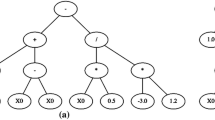Abstract
Nowadays, the ability to forecast the future, based only on past data, leads to strategic advantages, which may be the key to success in organizations. Time Series Forecasting allows the modeling of complex systems as black-boxes, being a focus of attention in several research arenas such as Operational Research, Statistics or Computer Science. On the other hand, Genetic and Evolutionary Algorithms (GEAs) are a novel technique increasingly used in Optimization and Machine Learning tasks. The present work reports on the forecast of several Time Series, by GEA based approaches, where Feature Analysis, based on statistical measures is used for dimensionality reduction. The handicap of the evolutionary approach is compared with conventional forecasting methods, being competitive.
Preview
Unable to display preview. Download preview PDF.
Similar content being viewed by others
References
Adriana Agapie and Alexandru Agapie. Forecasting the Economic Cycles Based on an Extension of the Holt-Winters Model. A Genetic Algorithms Approach. In Proceedings of the IEEE Computational Intelligence for Financial Forecasting Engineering, pages 96–99, 1997.
W. Banzhaf, P. Nordin, R. Keller, and F. Francone. Genetic Programming, An Introduction. Morgan Kaufmann Publishers, Inc, USA, 1998.
G. Box and G. Jenkins. Time Series Analysis: Forecasting and Control. Holden Day, San Francisco, USA, 1976.
C. Chai, C. Chuek, M. DP, and T. Huat. Time Series Modelling and Forecasting using Genetic Algorithms. In Proceedings of the First International Conference on Knowledge-Based Intelligent Electronic Systems, volume 1, pages 260–268, Adelaide, Australia, 1995.
A. Flexer. Statistical evaluation of neural networks experiments: Minimum requirements and current practice. In Proceedings of the 13th European Meeting on Cybernetics and Systems Research, volume 2, pages 1005–1008, Vienna, Austria, 1996.
John Holland. Adaptation in Natural and Artificial Systems. PhD thesis, University of Michigan, Ann Arbor, 1975.
C. Huang and H. Yang. A Time Series Approach To Short Term Load Forecasting Through Evolutionary Programming Structures. In Proceedings of the EMPD’95 Internacional Conference, pages 583–588, 1995.
R. Hyndman. Time Series Data Library. (http://www-personal.buseco.monash.edu.au/~hyndman/TSDL/), 2000.
G. Luger and W. Stubblefield. Artificial Intelligence, Structures and Strategies for Complex Problem Solving. Addison Wesley Longman, Inc., USA, 1998.
S. Makridakis and S. Wheelwright. Forecasting Methods for Management. John Wiley & Sons, New York, fifth edition, 1989.
Z. Michalewicz. Genetic Algorithms + Data Structures = Evolution Programs. Springer-Verlag, USA, third edition, 1996.
W. Sarle. Stopped Training and Other Remedies for Overfitting. In Proceedings of the 27th Symposium on the Interface of Computer Science and Statistics, pages 352–360, 1995.
G. Schwarz. Estimating the Dimension of a Model. The Annals of Statistics, 6: 461–4, 1978.
Author information
Authors and Affiliations
Editor information
Editors and Affiliations
Rights and permissions
Copyright information
© 2001 Springer-Verlag Berlin Heidelberg
About this paper
Cite this paper
Cortez, P., Rocha, M., Neves, J. (2001). Genetic and Evolutionary Algorithms for Time Series Forecasting. In: Monostori, L., Váncza, J., Ali, M. (eds) Engineering of Intelligent Systems. IEA/AIE 2001. Lecture Notes in Computer Science(), vol 2070. Springer, Berlin, Heidelberg. https://doi.org/10.1007/3-540-45517-5_44
Download citation
DOI: https://doi.org/10.1007/3-540-45517-5_44
Published:
Publisher Name: Springer, Berlin, Heidelberg
Print ISBN: 978-3-540-42219-8
Online ISBN: 978-3-540-45517-2
eBook Packages: Springer Book Archive




